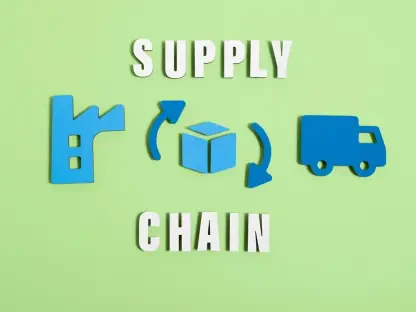In today’s global business environment, supply chain management is experiencing a significant transformation due to the integration of artificial intelligence (AI) and data analytics. What was once a sector characterized by manual, straightforward processes is now evolving into a more complex system intertwined with cutting-edge technology. This shift to a data-centric model is not simply about optimizing current operations; it’s enabling entirely new methods of supply chain management that prioritize efficiency, adaptability, and predictive capability.Employing AI in supply chains delivers a competitive edge by making systems more responsive and streamlining decision-making—a critical factor in the fast-paced global market. For example, AI-driven analytics can anticipate disruptions and suggest proactive adjustments, ensuring that businesses stay ahead of potential challenges.This revolution signifies a move away from traditional, reactive models to proactive strategies. As a result, AI has become indispensable for companies looking to thrive amidst global competition. The deployment of smart technologies in supply chains represents more than just an upgrade—it’s a redefinition of the industry standards, where the ability to quickly respond to emerging trends, forecast accurately, and efficiently navigate complexities shapes the success of businesses worldwide.
The Emergence of Predictive Inventory Management
Incorporating AI into inventory management has enabled predictive capabilities that were previously unachievable. By analyzing vast amounts of historical data and identifying patterns, AI algorithms can forecast future demand with remarkable accuracy. This forward-looking approach marks a significant departure from traditional inventory systems, which often relied on static, historical data. Now, with predictive models, companies can dynamically adjust stock levels well in advance, aligning inventory closely with real-time consumer demand and market changes.Moreover, the fusion of AI with inventory management practices furnishes an unparalleled proactive stance towards supply chain disruptions. Predictive analytics offers businesses the opportunity to identify potential weaknesses or threats before they escalate into more significant problems. From supplier issues to sudden spikes in demand, AI’s predictive insights enable supply chains to remain agile and resilient, two qualities that are indispensable in today’s fast-paced market environment.
Enhancing Demand Forecasting with AI
Advanced AI models are revolutionizing demand forecasting, particularly under the stress of market uncertainty. These models sift through complex, non-linear data patterns to produce actionable insights, empowering supply chain leaders to make swift, data-backed decisions. During the COVID-19 pandemic, AI systems demonstrated their robustness, quickly adapting to shifts in both supply and consumer behavior that caught many traditional forecasting methods off guard.The contribution of AI to demand forecasting lies in its ability to digest and interpret an immense array of data in real-time, offering a level of granularity that is unreachable for human analysis. This immediacy and accuracy of information afford an unprecedented level of agility in adjusting to the ever-shifting market demands. Consequently, AI is not only acting as a buffer against volatility but is also shaping a new methodology for demand forecasting, one that is adaptable and tuned to the subtleties of global markets.
Revolutionizing Warehouse Operations
AI’s transformative impact within supply chain management is perhaps nowhere more evident than in warehouse operations. AI has catalyzed the adoption of robotics and automation, remodeling warehouses into epicenters of efficiency. Where once manual handling dominated, now intelligent robots sort, pick, and package with near-perfect accuracy. This innovation reduces the margin of error and speeds up operations, contributing to a drastic enhancement in these once bottlenecked areas.Notable industry giants like Amazon and DHL have integrated AI and machine learning into their warehouses, reaping the benefits of streamlined processes and reduced operational costs. These businesses are paving the way for a new standard in warehouse management, where human labor is augmented by smart machines, and decision-making is informed by data-driven insights.
Mitigating Risks through Predictive Analytics
Beyond the optimization of routine tasks, AI empowers supply chain management with a proactive stance toward risk. Predictive tools, armed with AI’s deep learning capabilities, sift through data to identify potential threats before they materialize. From mitigating the effects of natural disasters to preempting logistical failures, AI plays a vital role in crafting robust supply chain strategies that can withstand external pressures.Companies that have incorporated these predictive analytics into their supply chain operations have shown increased resilience in the face of disruptions. For instance, proactive measures taken in anticipation of natural disasters enable swift responses that minimize the impact on supply chains. As enterprises continue to encounter a myriad of global risks, AI-backed predictive analytics emerge as the cornerstone of modern resilient supply chain networks.
The Future of Real-Time, Interconnected Supply Chains
As supply chain management ventures deeper into the AI age, we can expect the boundaries of what’s possible to be continually expanded. The advent of more sophisticated machine learning models will deliver enhanced visibility into the entire supply chain network. This transformation will provide stakeholders with the capability for instantaneous decision-making, tailored precisely to the needs of the moment.Predictive analytics will refine its edge by incorporating a broader spectrum of data, leading to ever more sophisticated logistical strategies. The future landscape of supply chain management will feature adaptive and intelligent networks that not only respond to current conditions but anticipate and shape future states. The certainty is that AI and data analytics will be at the heart of this ongoing evolution, driving supply chains toward higher levels of efficiency and resilience.









